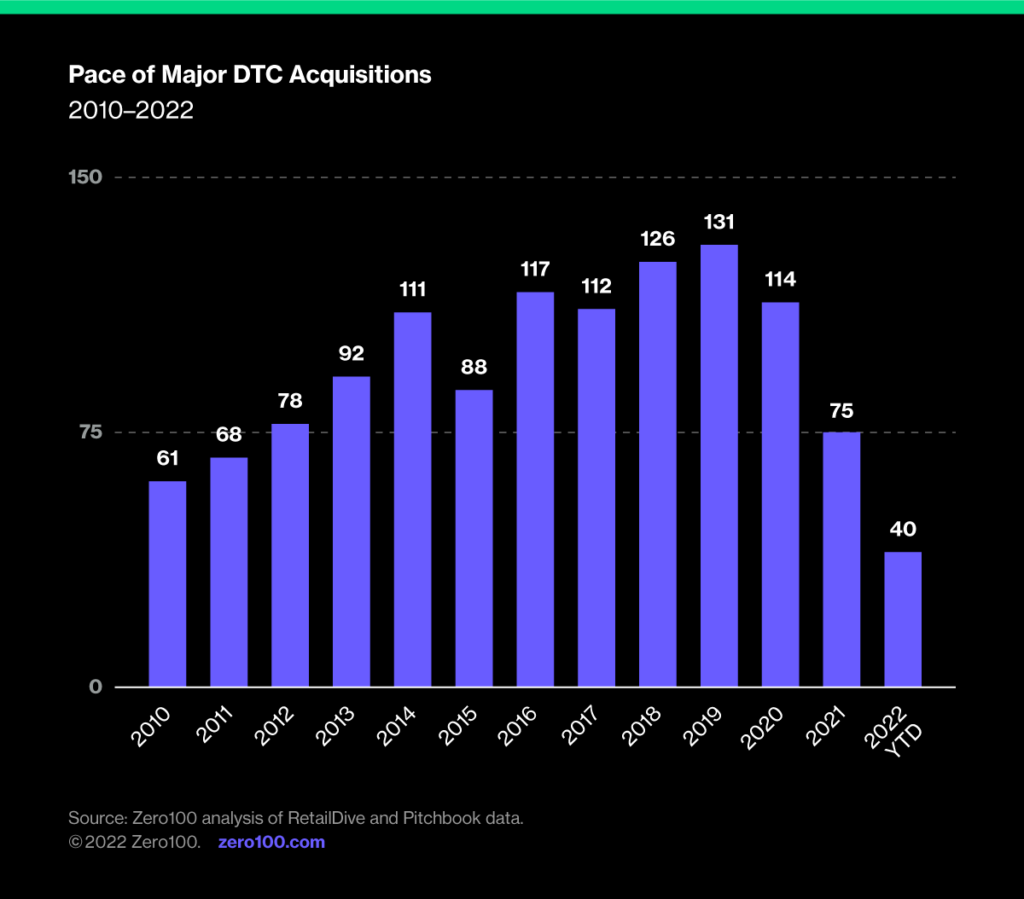
DTC Bargain Hunting: How to Shop for Good Acquisitions in a Buyer’s Market
Integrating supply chain operations is difficult, meaning sales projections frequently fail short. As the DTC frenzy cools off, the opportunity for brands seeking smart acquisitions might be even better.
While 2021 was hot for DTC brand deals with a flurry of trade acquisitions, SPACs, and IPOs... 2022 is proving to be a cooler market. According to Retail Dive, there were 75 major DTC deals in 2021, but just 40 deals so far in 2022. The good news for big retail and consumer brands looking for growth is that DTC brands that might have seemed too expensive a year ago could be well worth another look now. The key to buying smart, however, may be less about financial due diligence and more about supply chain strategy.
Buying Buzz
When Unilever bought Dollar Shave Club back in July 2016 for $1B, the idea of acquiring fast-growing direct-to-consumer (DTC) brands to spark growth with big league supply chain and retail channel capabilities made a lot of sense. Since then, success stories as diverse as Warby Parker, Casper and Bonobos have confirmed that new brands in established categories could take share and even build excitement with big investments in digital marketing and consumer connection. For brands built around some kind of sustainability story, like Tony Chocolonely, the appeal also includes a cool factor that many established players understandably crave.
Unfortunately, as is so often the case with acquisitions of any kind, things rarely go according to plan. Integrating the supply chain operations is tricky, which means sales projections based on assumed leverage of the acquirer's bigger market reach frequently fail to materialize. Plus, the creative touch is easily lost as meetings with corporate clog up the calendar and cash in the bank dulls the founder's passion. Deals that make sense on paper often miss the mark in practice.

And yet, I'll argue that this is still a fundamentally good idea for many big brands looking to keep growing earnings. It is even better with the lower price tag you may be looking at over the next year. So how do you pick winners?
Balance DTC's Digital Demand Gen with the Right Digital Supply Response
The common ingredients these DTC companies are bringing to the deal are almost all loaded on the demand chain side. They have great websites, outstanding social media presence, and often a bit of purpose-driven storytelling. In other words, they have spent most of their investment money building a digitally muscular demand chain complete with “Sell”, “Use”, and even some “Regenerate” functionality.

On the supply chain side, by contrast, most are either single-site manufacturing or fully outsourced. This means they have little or no digital maturity in their “Make” functions but instead take consumer feedback and apply it to product designs manually, without systematically managing product data in PDM/PLM systems.
They are also usually shipping via third party fulfillment or from a single site, low-automation warehouse operation. This means they have minimal experience tying inventory placement decisions, packaging choices or transport modes to sales forecasts and promotions management – i.e., little digital maturity in the “Move” functions.
Last, and most perilous for an acquiring brand, is that their often-compelling stories around sustainable sourcing, fair labor, or any other ESG-friendly supply chain practice – what we call “Regenerate” on the demand chain side – is often digitally overblown. Think Instagram influencers beating the drum for the social justice bona-fides of Ace & Tate and ask whether your corporate reputation will benefit from or suffer next to such a brand.
The advantage these DTC companies have in making and supporting these claims is that their sourcing, which is as digitally immature as everything else on the supply chain side of the business, can be kept honest with manual processes, and that's fine as long as cheap capital accepts the margin hit for higher growth.
Integrating any of these supply chain functions holistically into your scaled-up operations is critical to get the growth bump the acquisition promises. The right deal due diligence is all about exactly how you'll transfer their formulations, BOMs, specs, part numbers and pick lists from spreadsheets, shared file servers and third-party contracts to your big supply chain systems.
Supply Chain, Not Finance, Should Vet the Deal
If the homework says you can map their over-powered digital demand chain to your much more digitally mature supply chain... then you're good to go. Use their killer e-commerce capabilities to “Sell” and your killer fulfillment capabilities to “Move”. Harvest their consumer affinity (Use) to inform your product development and manufacturing (Plan & Make). Validate their sustainability story (Regenerate) with your responsible supply chain (Source).
If these sound like realistic integration plans, then maybe you have a deal.
Critical Reading
VOGUE
With Supply Chain Slowdowns, How Can Brands Navigate Viral Trends?
Commentary: To better adapt to rapid changes in demand driven by churning trend cycles (largely thanks to apps like Instagram and TikTok), retailers must focus on increasing transparency and agility across their supply chains.
#retail #transparency
TIME
TikTok Going Big on US E-Commerce? Job Listings Offer Clues
Commentary: Job listings looking for candidates to grow it's “Fulfillment by TikTok Shop” have popped up on LinkedIn over the past couple weeks, confirming TikTok's quick advance into e-commerce.
#ecommerce #tiktok
BLOOMBERG
Breakthroughs Are Helping Even Cement and Steel Go Electric
Commentary: Previously, it was thought that the only way to get around the high emissions associated with cement and steel plants was to use expensive tech like carbon capture and storage. Over the past few years, innovations like low-temperature iron and cement production are changing the narrative.
#industrial #emissions